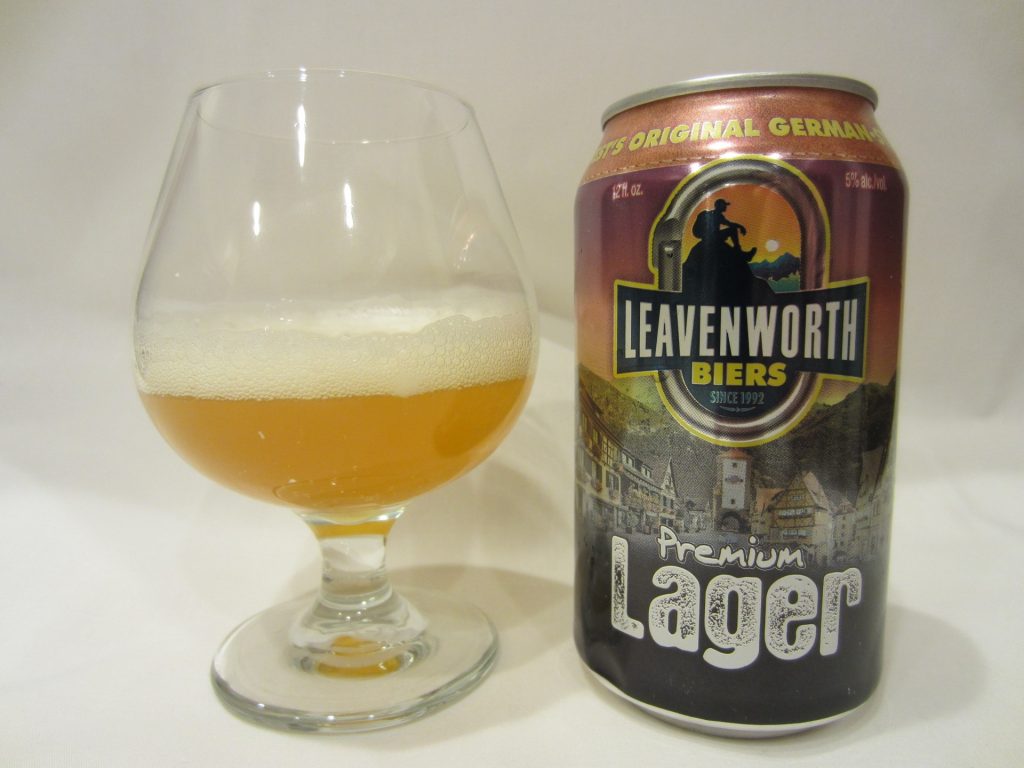 20. Leavenworth Premium Lager (Fish Brewing Company): If this were a citrusy-Pilsener contest, Leavenworth Premium Lager would be a serious contender. To be clear, the tasting panel really enjoyed this brew, although it reminded folks more of a tart orange-flavored lager than a German Pils. Maybe it was the batch, the kind of hops, or a freshness issue, but the aroma was unmistakably orange citrus as in orange marmalade, orange Pixy Stix, Sunny Delight, satsuma, mandarin orange Torani syrup and citrus pith (with a bit of Apple Jacks cereal for balance). Flavor? Orange peel, pith, fermented tangerine juice, with an eventual malt character of unsalted saltine crackers, finishing with lightly bitter hop and pith element.
20. Leavenworth Premium Lager (Fish Brewing Company): If this were a citrusy-Pilsener contest, Leavenworth Premium Lager would be a serious contender. To be clear, the tasting panel really enjoyed this brew, although it reminded folks more of a tart orange-flavored lager than a German Pils. Maybe it was the batch, the kind of hops, or a freshness issue, but the aroma was unmistakably orange citrus as in orange marmalade, orange Pixy Stix, Sunny Delight, satsuma, mandarin orange Torani syrup and citrus pith (with a bit of Apple Jacks cereal for balance). Flavor? Orange peel, pith, fermented tangerine juice, with an eventual malt character of unsalted saltine crackers, finishing with lightly bitter hop and pith element.
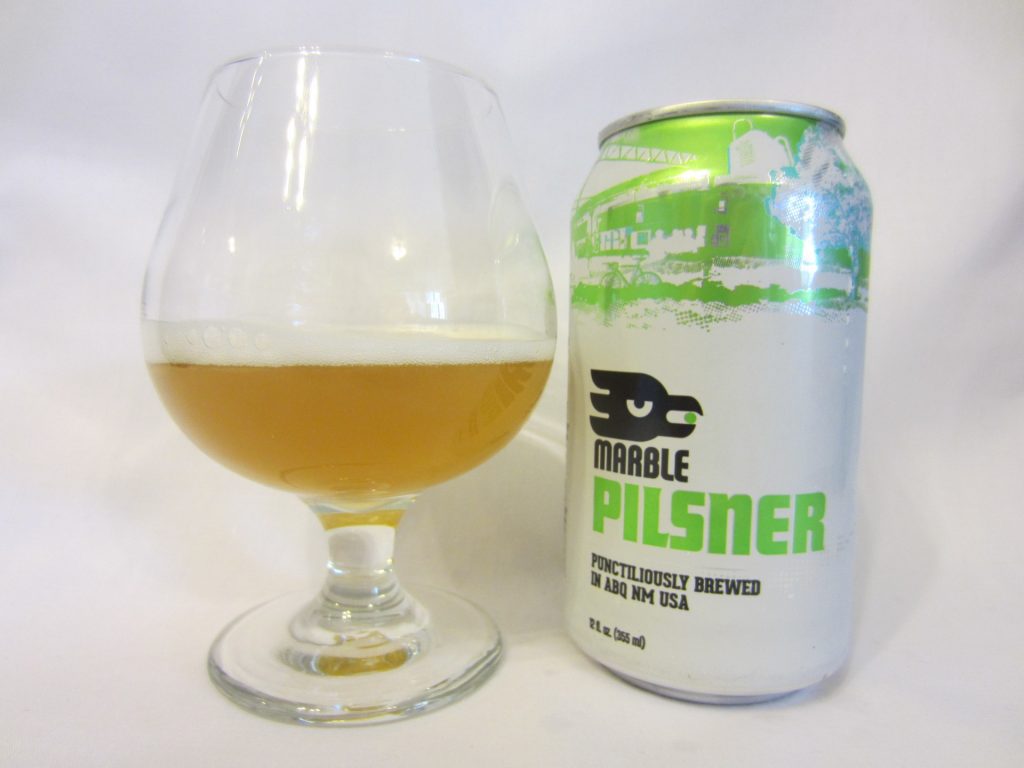 19. Pilsner (Marble Brewery): Marble’s Pilsner would make for a killer session IPL (it’s hop-tastic), but treads too heavy in the hop-zone for a traditional German Pils, despite being comprised of German ingredients. The initial aroma of this hazy deep gold Pils is a blast of piney hop pellets, biscuits, light pale malt, unsalted saltine cracker, lemon icing, with a hint of alcohol. Piney hop cones burst through in the flavor, drenching the taste buds in pithy alpha acid bitterness, easily overpowering the hint of lightly sweet malt, leaving behind a bit of a grassy/tannic aftertaste in the mouth.
19. Pilsner (Marble Brewery): Marble’s Pilsner would make for a killer session IPL (it’s hop-tastic), but treads too heavy in the hop-zone for a traditional German Pils, despite being comprised of German ingredients. The initial aroma of this hazy deep gold Pils is a blast of piney hop pellets, biscuits, light pale malt, unsalted saltine cracker, lemon icing, with a hint of alcohol. Piney hop cones burst through in the flavor, drenching the taste buds in pithy alpha acid bitterness, easily overpowering the hint of lightly sweet malt, leaving behind a bit of a grassy/tannic aftertaste in the mouth.
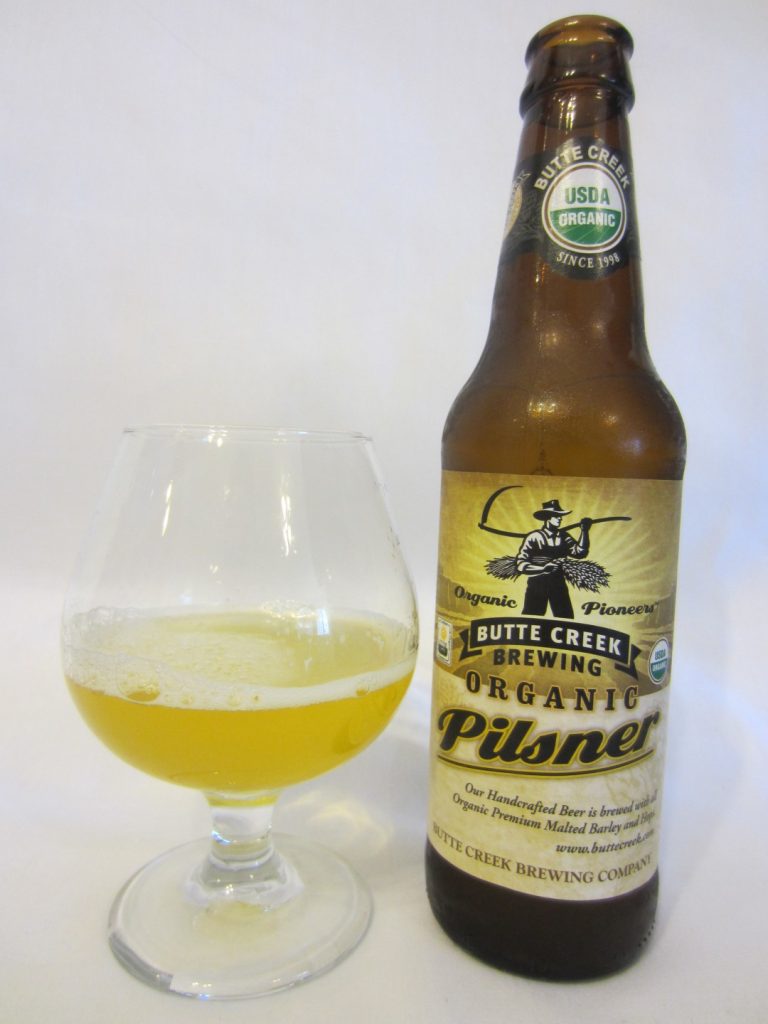 18. Butte Creek Organic Pilsner (Butte Creek Brewing Company): Butte Creek focuses on producing organic beer, and incorporates the use of pale and Carapils malts, and Cascade and Sterling hops in their take on a totally organic and smooth German Pils. Aroma: aged pear, honey, citrus leaf, baby corn, straw, Kix cereal, mild piney hops, and light alcohol. Medium-full bodied and smooth, flavor impressions of this Pils include baked black sesame seed crackers, slight apple juice, low sweetness, and a medium spicy hop bitterness that develops into a pithiness that lingers into the corn-like aftertaste.
18. Butte Creek Organic Pilsner (Butte Creek Brewing Company): Butte Creek focuses on producing organic beer, and incorporates the use of pale and Carapils malts, and Cascade and Sterling hops in their take on a totally organic and smooth German Pils. Aroma: aged pear, honey, citrus leaf, baby corn, straw, Kix cereal, mild piney hops, and light alcohol. Medium-full bodied and smooth, flavor impressions of this Pils include baked black sesame seed crackers, slight apple juice, low sweetness, and a medium spicy hop bitterness that develops into a pithiness that lingers into the corn-like aftertaste.
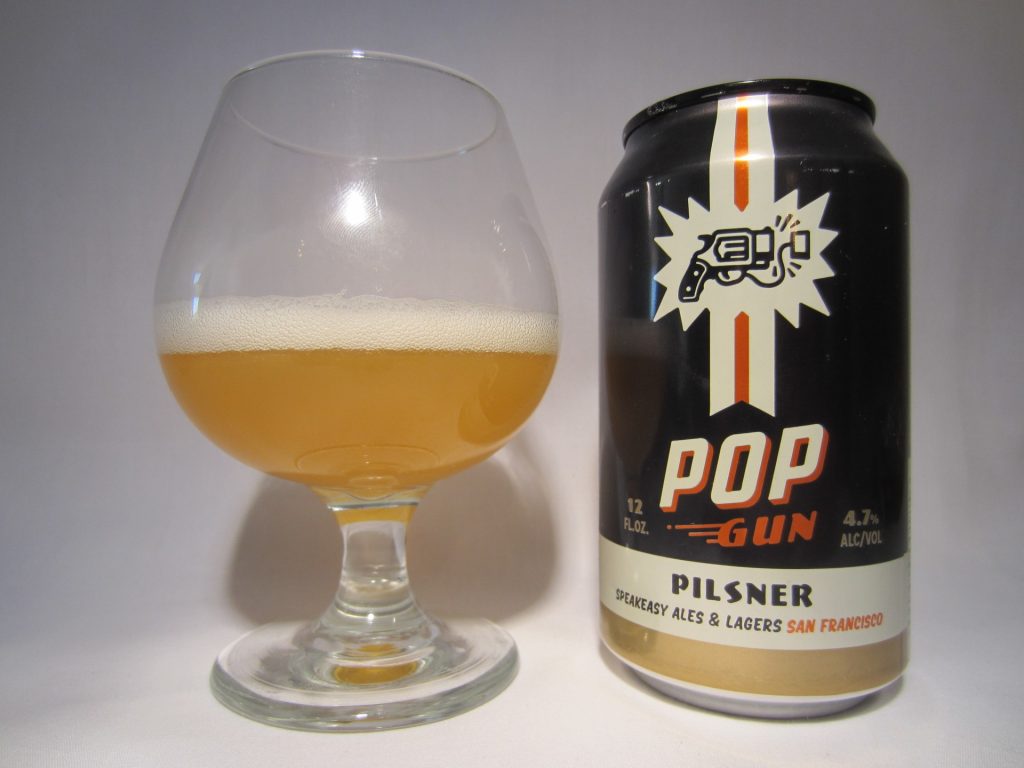 17. Pop Gun (Speakeasy Ales & Lagers): Award for the cleverest can design goes to Speakeasy for their custom black tab with those two painted-on cartoon eyes suspiciously peering around for the password to enter the blind tiger. Crack open the can and Pop Gun Pilsner pours a hazy lemon merengue pie filling color and pops with unexpected aromatics of lavender, pine resin, mild juniper, and unripe Asian pear. Flavor-wise, the malt character smacks of medium-sweet sugar cookie and dry hay which is easily overpowered by an almost perfume-like, resin-y hop bitterness which lingers well into the aftertaste of this medium-bodied Pils. Although Pop Gun is generally within the style guidelines of a German Pils, the hoppy siren song of the West Coast was simply too much for Speakeasy to resist.
17. Pop Gun (Speakeasy Ales & Lagers): Award for the cleverest can design goes to Speakeasy for their custom black tab with those two painted-on cartoon eyes suspiciously peering around for the password to enter the blind tiger. Crack open the can and Pop Gun Pilsner pours a hazy lemon merengue pie filling color and pops with unexpected aromatics of lavender, pine resin, mild juniper, and unripe Asian pear. Flavor-wise, the malt character smacks of medium-sweet sugar cookie and dry hay which is easily overpowered by an almost perfume-like, resin-y hop bitterness which lingers well into the aftertaste of this medium-bodied Pils. Although Pop Gun is generally within the style guidelines of a German Pils, the hoppy siren song of the West Coast was simply too much for Speakeasy to resist.
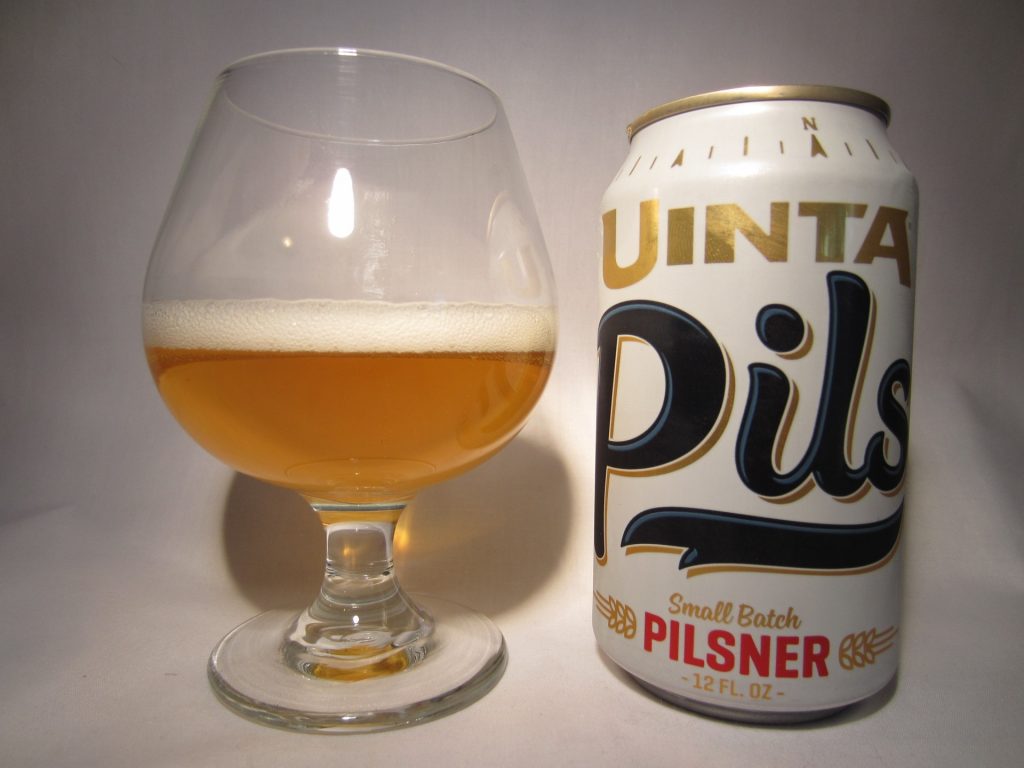 16. Pils Small Batch Pilsner (Uinta Brewing Company): Named after an oft mispronounced mountain range in Utah where the brewery originates, Uinta (you-in-tah) beers can be found in more than half of the states across the U.S. The brewery describes their Pils as a year-round porch beer with a crisp bitterness that balances gentle hop aromatics of citrus rind and fresh cut flowers. Sure enough at least one taster picked up on the citrus rind (lemon pith) in the aroma; other aromatics included light corn meal, Kix cereal, chalky mineral water, light unsalted saltine cracker, and Pilsner malt with a faint hint of alcohol. Mineral water character comes through in the taste along with corn husk, salty bitterness and pith. The beer is dry from start to finish, with impressions of dry playground grass in the husky, pithy aftertaste. The aroma is promising, but could do with a bit more Pilsner malt character in the flavor.
16. Pils Small Batch Pilsner (Uinta Brewing Company): Named after an oft mispronounced mountain range in Utah where the brewery originates, Uinta (you-in-tah) beers can be found in more than half of the states across the U.S. The brewery describes their Pils as a year-round porch beer with a crisp bitterness that balances gentle hop aromatics of citrus rind and fresh cut flowers. Sure enough at least one taster picked up on the citrus rind (lemon pith) in the aroma; other aromatics included light corn meal, Kix cereal, chalky mineral water, light unsalted saltine cracker, and Pilsner malt with a faint hint of alcohol. Mineral water character comes through in the taste along with corn husk, salty bitterness and pith. The beer is dry from start to finish, with impressions of dry playground grass in the husky, pithy aftertaste. The aroma is promising, but could do with a bit more Pilsner malt character in the flavor.
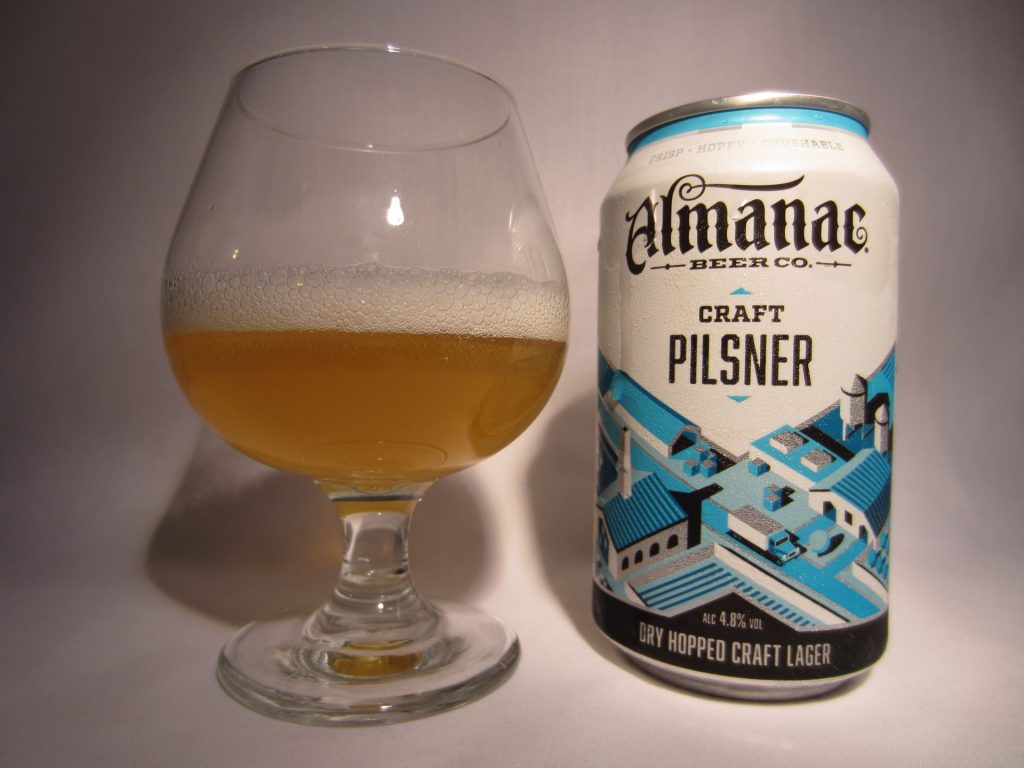 15. Craft Pilsner (Almanac Beer Co.): With its use of Citra, Mosaic and Simcoe hops, the aroma of this dry hopped West Coast version of a German Pils kicks up notes of grapefruit zest, citrus leaf, Tang, Sunny Delight, guava, and carnations with a hint of semi-sweet Pilsner malt and perhaps short bread hidden behind the hop-driven noise. Although atypical for a German Pils, a pleasant grapefruit character shines through in the flavor, developing into a medium pithy bitterness which lingers well into the aftertaste of this medium-carbonated lager. Brewed with 100% Pilsner malt, a bit of soft malt flavor is detectable underneath the hoppy rubble of this West Coast, hop-centric Pils.
15. Craft Pilsner (Almanac Beer Co.): With its use of Citra, Mosaic and Simcoe hops, the aroma of this dry hopped West Coast version of a German Pils kicks up notes of grapefruit zest, citrus leaf, Tang, Sunny Delight, guava, and carnations with a hint of semi-sweet Pilsner malt and perhaps short bread hidden behind the hop-driven noise. Although atypical for a German Pils, a pleasant grapefruit character shines through in the flavor, developing into a medium pithy bitterness which lingers well into the aftertaste of this medium-carbonated lager. Brewed with 100% Pilsner malt, a bit of soft malt flavor is detectable underneath the hoppy rubble of this West Coast, hop-centric Pils.
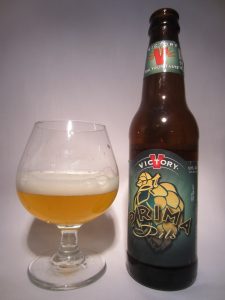 14. Prima Pils (Victory Brewing Company): Prima Pils is typically a fan favorite among craft beer enthusiasts, although the hop profile changes slightly from year-to-year based on crop yields, with the bitterness generally exceeding the upper boundary of IBUs for traditional German Pils. The aroma exhibits a hint of spicy pine, hop resin, green pineapple leafs, Pilsner malt, a touch of powdered sugar, watermelon rind and celery salt. The hops and malts are evenly balanced in the flavor, with notes of rye, salt and pepper, celery salt and pine needles. Prima Pils scored well and was evenly balanced, but presents a bigger malt and hop profile than the more restrained character of a classic Pils.
14. Prima Pils (Victory Brewing Company): Prima Pils is typically a fan favorite among craft beer enthusiasts, although the hop profile changes slightly from year-to-year based on crop yields, with the bitterness generally exceeding the upper boundary of IBUs for traditional German Pils. The aroma exhibits a hint of spicy pine, hop resin, green pineapple leafs, Pilsner malt, a touch of powdered sugar, watermelon rind and celery salt. The hops and malts are evenly balanced in the flavor, with notes of rye, salt and pepper, celery salt and pine needles. Prima Pils scored well and was evenly balanced, but presents a bigger malt and hop profile than the more restrained character of a classic Pils.
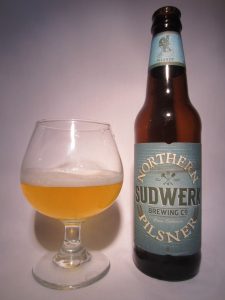 13. Northern Pilsner (Sudwerk Brewing Company): Not only is Sudwerk a brewery that specializes in German-style beers, but it also doubles as a classroom for a few UC Davis brewing programs. This self-described Northern German style Pils pours a pinky of egg shell-white head on top a clear, light honey colored brew. The aroma exhibits clean Pilsner malt, a hint of raw corn tortilla, saltine cracker, shortbread cookie, with very little if any bitter hop character. Noted flavor descriptors: very mild corn chip, citrus oils, pith, and light golden honeydew melon juice. Northern Pilsner is crisp and mildly alcoholic with a medium body, medium-high carbonation and a pithy bitterness appearing mid-palate and lingering well into the aftertaste.
13. Northern Pilsner (Sudwerk Brewing Company): Not only is Sudwerk a brewery that specializes in German-style beers, but it also doubles as a classroom for a few UC Davis brewing programs. This self-described Northern German style Pils pours a pinky of egg shell-white head on top a clear, light honey colored brew. The aroma exhibits clean Pilsner malt, a hint of raw corn tortilla, saltine cracker, shortbread cookie, with very little if any bitter hop character. Noted flavor descriptors: very mild corn chip, citrus oils, pith, and light golden honeydew melon juice. Northern Pilsner is crisp and mildly alcoholic with a medium body, medium-high carbonation and a pithy bitterness appearing mid-palate and lingering well into the aftertaste.
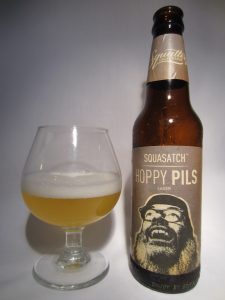 12. Squatters Sasquatch Hoppy Pils (Utah Brewers Cooperative): Despite its hoppy moniker, Sasquatch Hoppy Pils’ aroma is more malt-forward with notes of bran, Triscuits, dry hay, grainy malt, saltine cracker and mineral water with perhaps some citrus pith. The flavor follows up with a punch of tonic water, soft malt, and salt with a bit of a chalky mouthfeel. The hops are mild and imbue more of a tanginess than bitterness— like tiny unripe green grapes. Sasquatch finishes exceptionally dry with an aftertaste of husky dry grain and salted toasted pumpkin seeds.
12. Squatters Sasquatch Hoppy Pils (Utah Brewers Cooperative): Despite its hoppy moniker, Sasquatch Hoppy Pils’ aroma is more malt-forward with notes of bran, Triscuits, dry hay, grainy malt, saltine cracker and mineral water with perhaps some citrus pith. The flavor follows up with a punch of tonic water, soft malt, and salt with a bit of a chalky mouthfeel. The hops are mild and imbue more of a tanginess than bitterness— like tiny unripe green grapes. Sasquatch finishes exceptionally dry with an aftertaste of husky dry grain and salted toasted pumpkin seeds.
Comedian David Cross doesn’t work at a brewery in Salt Lake City, but apparently his Doppelgänger (Douglass Styer) who graces the label of Sasquatch Hoppy Pils does:
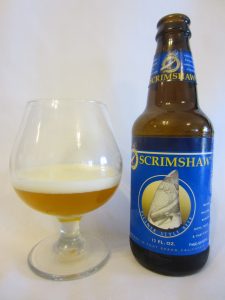 11. Scrimshaw Pilsner (North Coast Brewing Co.): Named for the delicate engravings popularized by 19th century seafarers, Scrimshaw pours a nearly clear honey-gold body with one finger of aged-paper colored head. Aroma: hop pellets, buttered crunchy thin breadsticks with sesame seeds, Wheat Thins, corn bread, celery, and mild citrus pith. Flavor impressions in this medium-high carbonated Pils include pink peppercorn, salt, sharp seltzer, medium-low malt sweetness, Haribo Gummy Bears, bitter herb, and a hint of cilantro.
11. Scrimshaw Pilsner (North Coast Brewing Co.): Named for the delicate engravings popularized by 19th century seafarers, Scrimshaw pours a nearly clear honey-gold body with one finger of aged-paper colored head. Aroma: hop pellets, buttered crunchy thin breadsticks with sesame seeds, Wheat Thins, corn bread, celery, and mild citrus pith. Flavor impressions in this medium-high carbonated Pils include pink peppercorn, salt, sharp seltzer, medium-low malt sweetness, Haribo Gummy Bears, bitter herb, and a hint of cilantro.
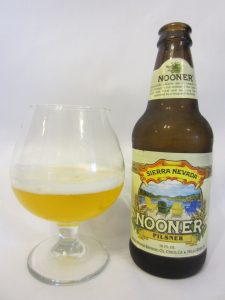 10. Nooner Pilsner (Sierra Nevada Brewing Co.): Known for their hop-forward beers, Sierra Nevada’s Pils is assertively bitter at 38 IBUs, and presents aromatics of spicy hops with a hint of grapefruit pith that sparkle between Pilsner malt notes of corn silk, Kix cereal, corn bread muffin top, frostingless white cake with a whiff of gummy bears. Instead of imparting big, bold grapefruit or piney flavors in the taste, the hops, giving an impression of celery salt, play more of an assertive bittering role allowing for the medium-low Pilsner malt sweetness to share the stage in this medium-high carbonated brew, leaving behind an aftertaste of celery and mild pithy bitterness.
10. Nooner Pilsner (Sierra Nevada Brewing Co.): Known for their hop-forward beers, Sierra Nevada’s Pils is assertively bitter at 38 IBUs, and presents aromatics of spicy hops with a hint of grapefruit pith that sparkle between Pilsner malt notes of corn silk, Kix cereal, corn bread muffin top, frostingless white cake with a whiff of gummy bears. Instead of imparting big, bold grapefruit or piney flavors in the taste, the hops, giving an impression of celery salt, play more of an assertive bittering role allowing for the medium-low Pilsner malt sweetness to share the stage in this medium-high carbonated brew, leaving behind an aftertaste of celery and mild pithy bitterness.
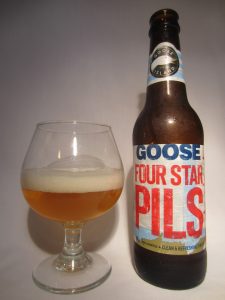 9. Four Star Pils (Goose Island Beer Co.): While Goose Island is no longer technically considered a craft brewery after being bought out by AB InBev, they can still crank out some tasty beer. Maybe it was destiny, but we also ended up giving Goose Island’s Four Star Pils four-out-of-five stars (heh). The Pils pours a brilliant deep brass color, and pushes out aromatics of hay, marshmallow, nectarine, orange Pixie Stix, citrus leaf, pith, lemon candy sugar, short bread, soft mineral water with a nip of salt. The medium-low pale malt sweetness in the flavor is overpowered by the bitter, zesty mix of German and American hop oils, which turn pithy, tannic and astringent in the aftertaste. If the alpha acids were dialed back allowing for a softer Pilsner malt grain character to eke through, we might be approaching closer to five-stars here. Until then, we’re looking at a Four Star Pils.
9. Four Star Pils (Goose Island Beer Co.): While Goose Island is no longer technically considered a craft brewery after being bought out by AB InBev, they can still crank out some tasty beer. Maybe it was destiny, but we also ended up giving Goose Island’s Four Star Pils four-out-of-five stars (heh). The Pils pours a brilliant deep brass color, and pushes out aromatics of hay, marshmallow, nectarine, orange Pixie Stix, citrus leaf, pith, lemon candy sugar, short bread, soft mineral water with a nip of salt. The medium-low pale malt sweetness in the flavor is overpowered by the bitter, zesty mix of German and American hop oils, which turn pithy, tannic and astringent in the aftertaste. If the alpha acids were dialed back allowing for a softer Pilsner malt grain character to eke through, we might be approaching closer to five-stars here. Until then, we’re looking at a Four Star Pils.
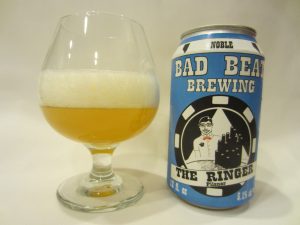 8. The Ringer (Bad Beat Brewing): Straight from the unforgiving deserts of Nevada where a refreshing Pils must be all the more desirable, The Ringer pours more than a finger of fluffy ivory head that persists, revealing a hazy pale gold body underneath. Pale Pilsner malt descriptors abound in the aroma including uncooked corn on the cob, Kix cereal, honey suckle, biscuits, light pear, mild alcohol with perhaps a touch of grass. The initial flavor of this well carbonated Pils is med-low sweet apple juice and flour which pass the baton to an oily hop bitterness mid-palate that continues to develop into an almost perfume-like bitterness in the finish and aftertaste.
8. The Ringer (Bad Beat Brewing): Straight from the unforgiving deserts of Nevada where a refreshing Pils must be all the more desirable, The Ringer pours more than a finger of fluffy ivory head that persists, revealing a hazy pale gold body underneath. Pale Pilsner malt descriptors abound in the aroma including uncooked corn on the cob, Kix cereal, honey suckle, biscuits, light pear, mild alcohol with perhaps a touch of grass. The initial flavor of this well carbonated Pils is med-low sweet apple juice and flour which pass the baton to an oily hop bitterness mid-palate that continues to develop into an almost perfume-like bitterness in the finish and aftertaste.
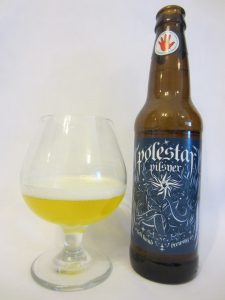 7. Polestar Pilsner (Left Hand Brewing Company): Brewed with a combination of German and American hops like Magnum, Mt. Hood and Sterling, Polestar Pilsner pours a nearly clear pale gold, with aromas of tupelo honey, poppy seed cracker, Kix cereal, a hint of chlorine, and rubber ducky. Well carbonated, the flavor is balanced towards the hops with a medium-high hop bitterness, notes of pith, salt, Juicy Fruit gum, with a light sweet malt character appearing in the finish.
7. Polestar Pilsner (Left Hand Brewing Company): Brewed with a combination of German and American hops like Magnum, Mt. Hood and Sterling, Polestar Pilsner pours a nearly clear pale gold, with aromas of tupelo honey, poppy seed cracker, Kix cereal, a hint of chlorine, and rubber ducky. Well carbonated, the flavor is balanced towards the hops with a medium-high hop bitterness, notes of pith, salt, Juicy Fruit gum, with a light sweet malt character appearing in the finish.
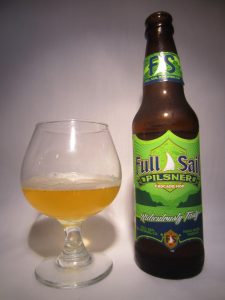 6. Full Sail Pilsner (Full Sail Brewery): Overall, Full Sail Pilsner is a medium-bodied brew that strikes a malt-hop balance closer to what’s expected in a German Pils, although it leans more towards the hops and strays from the traditional German Pils by incorporating American cascade hops. Aroma notes: Wet grass (algae & duckweed), wet stone, water chestnuts and wet yarn. Flavor impressions: minerally, chalky, white pepper, citric acid tartness, pith, cane sugar, salt, dehydrated pineapple. Not overly bitter, although bitterness lingers into the aftertaste.
6. Full Sail Pilsner (Full Sail Brewery): Overall, Full Sail Pilsner is a medium-bodied brew that strikes a malt-hop balance closer to what’s expected in a German Pils, although it leans more towards the hops and strays from the traditional German Pils by incorporating American cascade hops. Aroma notes: Wet grass (algae & duckweed), wet stone, water chestnuts and wet yarn. Flavor impressions: minerally, chalky, white pepper, citric acid tartness, pith, cane sugar, salt, dehydrated pineapple. Not overly bitter, although bitterness lingers into the aftertaste.
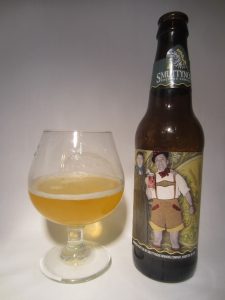 5. Smuttynose Vunderbar (Smuttynose Brewing Co.): DMS, or dimethyl sulfide, is fancy beer taster lingo used to describe a range of corn-like aromas and flavors found in beer. And unlike the majority of other beer styles, the presence of DMS in a German-style Pils isn’t a flaw, but can actually be quite welcome in low amounts. In the case of Smuttynose Vunderbar, tasters picked out pleasant Pilsner malt-derived DMS aromas reminiscent of Corn Pops, corn meal, cooked grits and rice cakes with a touch of honey, while the hops contribute mild floral components of alfalfa flowers and green tea with just a hint of alcohol. In the flavor, a fair balance was struck between bitter hops and the honeydew like sweetness, with hops edging out the malt in the finish.
5. Smuttynose Vunderbar (Smuttynose Brewing Co.): DMS, or dimethyl sulfide, is fancy beer taster lingo used to describe a range of corn-like aromas and flavors found in beer. And unlike the majority of other beer styles, the presence of DMS in a German-style Pils isn’t a flaw, but can actually be quite welcome in low amounts. In the case of Smuttynose Vunderbar, tasters picked out pleasant Pilsner malt-derived DMS aromas reminiscent of Corn Pops, corn meal, cooked grits and rice cakes with a touch of honey, while the hops contribute mild floral components of alfalfa flowers and green tea with just a hint of alcohol. In the flavor, a fair balance was struck between bitter hops and the honeydew like sweetness, with hops edging out the malt in the finish.
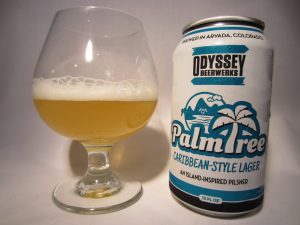 4. Palm Tree Caribbean Lager (Odyssey Beerwerks): Don’t let the name fool you: this brew hails from the snowy city of Arvada, CO., not the sunny West Indies. And aside from a hint of raffia in the nose, there isn’t anything particularly tropical about this well-balanced self-described German Pils. Other aromatics include salt and flour, Sprite, pie crust, faint yellow corn, flour tortilla and a wisp of lemon cookie. The flavor is a delicate balance displaying notes of saltine crackers, light lemon tonic water, medium bitterness supported by a pleasant medium carbonation and a starchy soft water mouthfeel. The addition of malted rye goes unnoticed in this well-balanced and refreshing example of a German Pils. (Don’t be alarmed if you find some yeast at the bottom of the can… Vitamin B is good for you!)
4. Palm Tree Caribbean Lager (Odyssey Beerwerks): Don’t let the name fool you: this brew hails from the snowy city of Arvada, CO., not the sunny West Indies. And aside from a hint of raffia in the nose, there isn’t anything particularly tropical about this well-balanced self-described German Pils. Other aromatics include salt and flour, Sprite, pie crust, faint yellow corn, flour tortilla and a wisp of lemon cookie. The flavor is a delicate balance displaying notes of saltine crackers, light lemon tonic water, medium bitterness supported by a pleasant medium carbonation and a starchy soft water mouthfeel. The addition of malted rye goes unnoticed in this well-balanced and refreshing example of a German Pils. (Don’t be alarmed if you find some yeast at the bottom of the can… Vitamin B is good for you!)
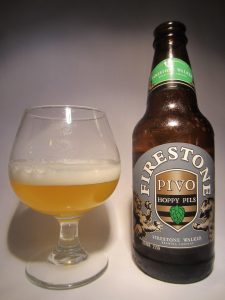 3. Pivo Pils (Firestone Walker Brewing Co.): Firestone markets Pivo Pils as a classically rendered Pilsner with a West Coast dry-hopping twist, showcasing stylistic influences from Germany, Italy and the Czech Republic. Despite all the non-German influence, Pivo Pils still climbed to the # 3 spot on the list, and is reminiscent of many of the fine German style Pils of Europe. Herbaceous hop-driven aromatics of pine needle, dry grass and celery salt combine with notes of distinctively soft Pilsner malt, pumice stone, and glue stick/rubber ducky. Offering up a crisp flavor with a touch of corn meal mid-palate, Pivo Pils is balanced towards the hops with a note of pith but restrained enough to allow for a pleasantly sweet Pilsner malt finish. Medium-bodied with no intense lingering hop oil bitterness in the somewhat salty aftertaste.
3. Pivo Pils (Firestone Walker Brewing Co.): Firestone markets Pivo Pils as a classically rendered Pilsner with a West Coast dry-hopping twist, showcasing stylistic influences from Germany, Italy and the Czech Republic. Despite all the non-German influence, Pivo Pils still climbed to the # 3 spot on the list, and is reminiscent of many of the fine German style Pils of Europe. Herbaceous hop-driven aromatics of pine needle, dry grass and celery salt combine with notes of distinctively soft Pilsner malt, pumice stone, and glue stick/rubber ducky. Offering up a crisp flavor with a touch of corn meal mid-palate, Pivo Pils is balanced towards the hops with a note of pith but restrained enough to allow for a pleasantly sweet Pilsner malt finish. Medium-bodied with no intense lingering hop oil bitterness in the somewhat salty aftertaste.
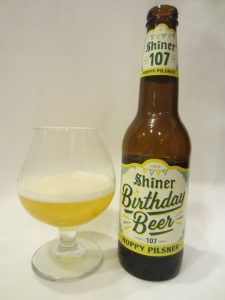 2. Shiner Birthday Beer 107 – Hoppy Pilsner (Spoetzl Brewery/Shiner): If there’s one area where a brewery founded by German immigrates should shine (zing!), it’s when crafting a German Pilsener— and a fine Pils did Shiner craft indeed. Named after the brewery’s 107th year of cranking out German brews deep in the heart of Texas, Shiner Birthday Beer 107 pours a brilliant golden-yellow, with aromas of butter cookies, biscuity malt, tea light candles, a hint of candy corn, lightly buttered saltine cracker, peppered with a hop component of dry pine needles. Flavor-wise, the balance is tipped slightly in favor of the malt with medium-sweet notes of butter cookies (think Pepperidge Farm Chessmen Cookies) and saltine crackers being cut by pleasantly bitter, salty, and mildly alcoholic undertones.
2. Shiner Birthday Beer 107 – Hoppy Pilsner (Spoetzl Brewery/Shiner): If there’s one area where a brewery founded by German immigrates should shine (zing!), it’s when crafting a German Pilsener— and a fine Pils did Shiner craft indeed. Named after the brewery’s 107th year of cranking out German brews deep in the heart of Texas, Shiner Birthday Beer 107 pours a brilliant golden-yellow, with aromas of butter cookies, biscuity malt, tea light candles, a hint of candy corn, lightly buttered saltine cracker, peppered with a hop component of dry pine needles. Flavor-wise, the balance is tipped slightly in favor of the malt with medium-sweet notes of butter cookies (think Pepperidge Farm Chessmen Cookies) and saltine crackers being cut by pleasantly bitter, salty, and mildly alcoholic undertones.
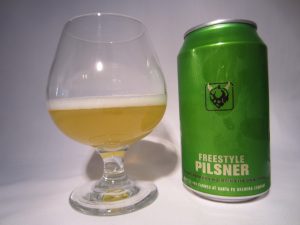 1. Freestyle Pilsner (Santa Fe Brewing Company): Sante Fe Brewing Co. goes out of its way to persuade the consumer that its Pilsner does not like to be categorized (despite it being labeled as a Pilsner). They proclaim the beer is assertively hopped… That it’s “doing its own thing”. Hell, the can is even colored hop-green with images of “good and evil” hops emblazoned on it implying a mega-hoppy brew.
1. Freestyle Pilsner (Santa Fe Brewing Company): Sante Fe Brewing Co. goes out of its way to persuade the consumer that its Pilsner does not like to be categorized (despite it being labeled as a Pilsner). They proclaim the beer is assertively hopped… That it’s “doing its own thing”. Hell, the can is even colored hop-green with images of “good and evil” hops emblazoned on it implying a mega-hoppy brew.
Based on all this, you wouldn’t be out of line to expect a beer that resembles yet another seemingly typical American-brewed version of an over-hopped Pils— something closer to an IPL than a Pils.
But despite Sante Fe’s best efforts to convince you otherwise, what you have with “Freestyle Pilsner” is simply a damn fine example of what a traditional German Pils should be— which is in large part due to a masterful display of restraint with respect to the use of hops (not exactly something synonymous with American craft beer).
Shockingly, the aroma isn’t overly hoppy, instead playing up notes of pale malt, flour, salt, white pepper, light honey, untoasted scone, sugar cookies, and white cake with a hint of pear. The clean flavor profile is extremely well-balanced where the medium hop bitterness acts as a perfect counterweight to the light Pilsner malt sweetness. Notes of saltine cracker and light alcohol develop mid-palate and linger into the mildly bitter aftertaste.
As one taster remarked, “Are you sure this Pils wasn’t brewed in Europe?”
We’re sure.
Already the 2016 Gold Medal winner of the Can Can Premier Canned Beer Competition in the German-Style Pilsner Category, Sante Fe is clearly doing something right.
Perhaps for the Sante Fe Brewing Co., “doing its own thing” means bucking the pervasive trend of many American craft brewers who over-hop just about anything they touch, and instead deliver an exceptionally traditional example of a German Pils, so much so that the brewery should consider changing the name of their Pils from “Freestyle” to “to-style”.
Final Thoughts: When is a Pils Not a Pils?
If we noticed one reoccurring theme that stood out in this admittedly small sample size of American-brewed German-style Pils, it was this: the majority of beers in the line-up were heavy on the hops, particularly in the aroma and flavor, more so than the best examples of traditional German Pils.
Does this mean that an over-hopped version of a Pils is “bad”?
Absolutely not.
Many of the hoppy brews in our sample were seriously tasty, but we couldn’t really say that they were unmistakably representative of the classic German Pils beer style, which is why in this specific review they didn’t score higher than they did.
Now, if this were a review of hoppy Pilseners, we’d have some very stiff competition and undoubtedly a different order in the rankings.
But in defense of most of the breweries that put out a hopped-up version of a Pils, many of them indicated as much on the packaging, so fair warning to the consumer.
It’s also worth mentioning that German Pils is a relatively unforgiving style of beer to brew, meaning that if the brewer’s recipe steps a bit too far outside of the somewhat narrow style guidelines, it becomes very noticeable very quickly.
And not to get too philosophical, but after tasting several overly-hopped Pils (whether intentionally over-hopped or not), the question arises: When is a Pils not a Pils?
To be clear, when it comes to brewing any classic beer style, in this case German Pils, there is a certain point at which a particular recipe can fall just outside of the style guidelines such that a beer ceases to be representative of the style, and in some cases can become a totally different beer style altogether. For example, if an American Pale Ale exceeds 50 IBUs, it may technically be considered an American IPA. In the case of a hopped-up American Pale ale, it wouldn’t make much sense to call it anything other than an American IPA and judge it accordingly.
However, with respect to German Pils, there really isn’t a well-defined beer style for a hoppy Pils to fit in to. Perhaps the closest thing might be an IPL (India Pale Lager), but even then an IPL would typically showcase American hops, and not the kind of German hops typical of a German Pils.
That said, if hoppy German Pilseners really start to take off, it’s possible a new beer style can be created to describe them.
Perhaps “German IPL”… or maybe “American-German Pils”?
But until such time, hoppy Pils will remain just that: hoppy Pils.
In other words, a Pils, but not a Pils.
[Fun fact: German-style Pilsener is often referred to as “Pils” in Germany and is commonly spelled “Pilsener” in contrast to Czech “Pilsner”. However, many German brewers may also spell their German Pilseners as “Pilsner”. A good rule of thumb is that if a beer is spelled “Pilsener” it’s almost certainly a German-style Pils (as there is probably no Czech-brewed Pilsner spelled “Pilsener”).]
Like this post? Well, thanks- we appreciate you.
Want to leave a comment below or Tweet this? Much obliged!
Want to read more beer inspired thoughts? Come back any time, friend us on Facebook, or follow us on Twitter:
Or feel free to drop me a line at: dan@beersyndicate.com
Hi, I’m Dan: Beer Editor for BeerSyndicate.com, Beer and Drinking Blogger, BJCP Beer Judge, Gold Medal-Winning Homebrewer, Beer Reviewer, AHA Member, Beer Traveler, and Shameless Beer Promoter with degrees in Philosophy and Business.

Pages: 12

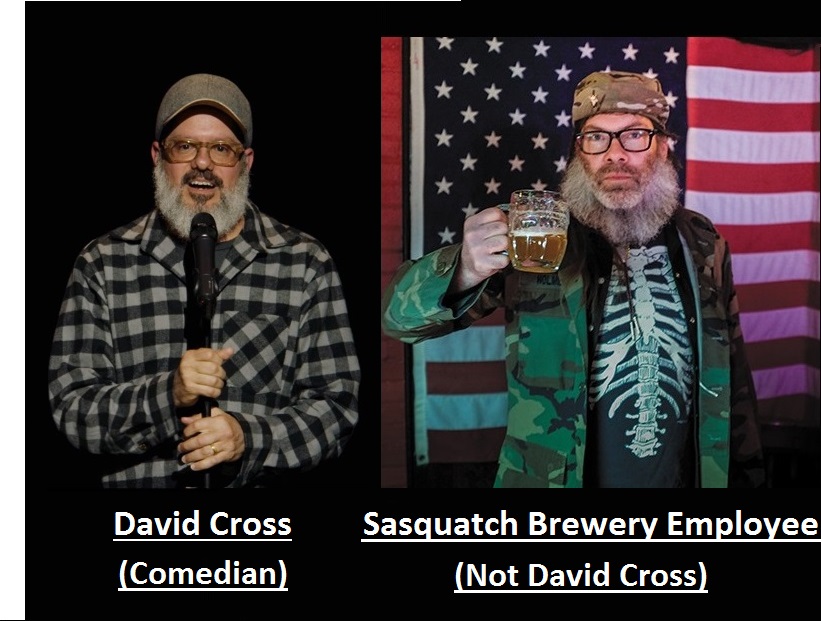




Leave a Reply
You must be logged in to post a comment.